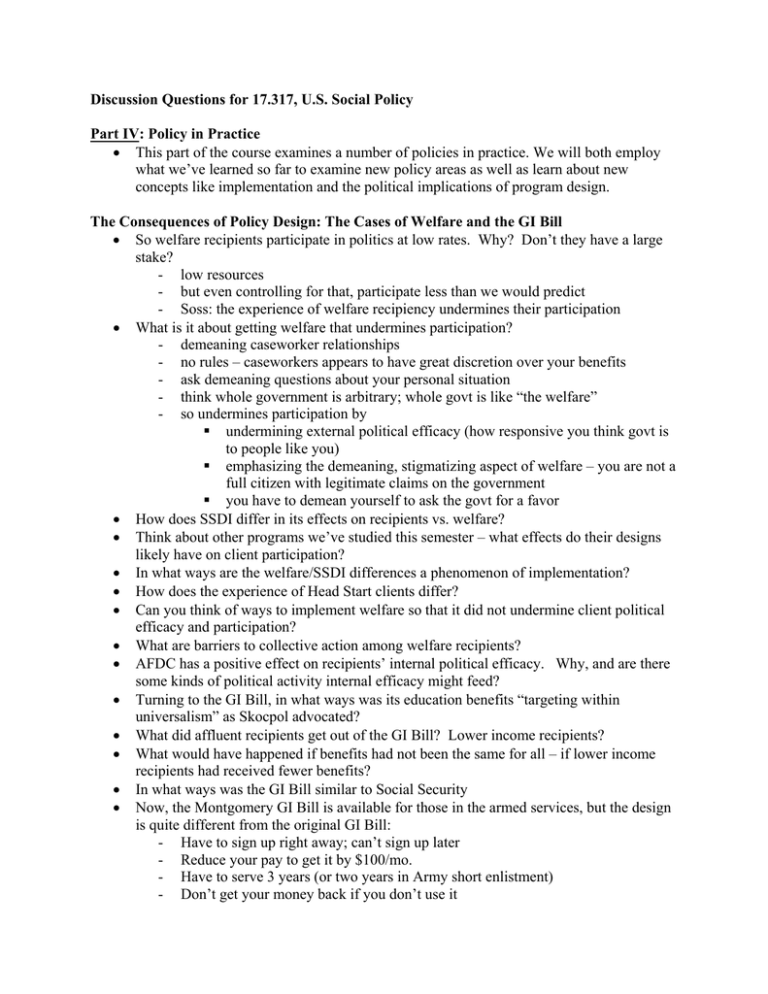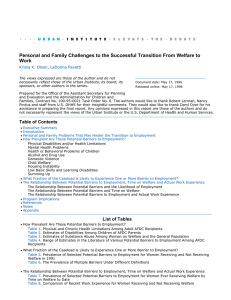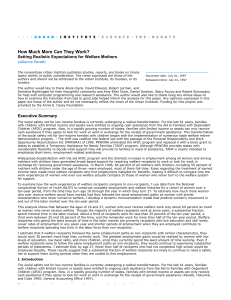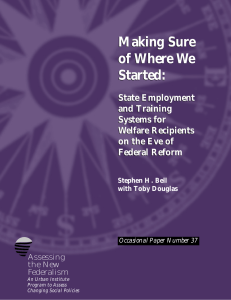Discussion Questions for 17.317, U.S. Social Policy
advertisement

Discussion Questions for 17.317, U.S. Social Policy Part IV: Policy in Practice • This part of the course examines a number of policies in practice. We will both employ what we’ve learned so far to examine new policy areas as well as learn about new concepts like implementation and the political implications of program design. The Consequences of Policy Design: The Cases of Welfare and the GI Bill • So welfare recipients participate in politics at low rates. Why? Don’t they have a large stake? - low resources - but even controlling for that, participate less than we would predict - Soss: the experience of welfare recipiency undermines their participation • What is it about getting welfare that undermines participation? - demeaning caseworker relationships - no rules – caseworkers appears to have great discretion over your benefits - ask demeaning questions about your personal situation - think whole government is arbitrary; whole govt is like “the welfare” - so undermines participation by undermining external political efficacy (how responsive you think govt is to people like you) emphasizing the demeaning, stigmatizing aspect of welfare – you are not a full citizen with legitimate claims on the government you have to demean yourself to ask the govt for a favor • How does SSDI differ in its effects on recipients vs. welfare? • Think about other programs we’ve studied this semester – what effects do their designs likely have on client participation? • In what ways are the welfare/SSDI differences a phenomenon of implementation? • How does the experience of Head Start clients differ? • Can you think of ways to implement welfare so that it did not undermine client political efficacy and participation? • What are barriers to collective action among welfare recipients? • AFDC has a positive effect on recipients’ internal political efficacy. Why, and are there some kinds of political activity internal efficacy might feed? • Turning to the GI Bill, in what ways was its education benefits “targeting within universalism” as Skocpol advocated? • What did affluent recipients get out of the GI Bill? Lower income recipients? • What would have happened if benefits had not been the same for all – if lower income recipients had received fewer benefits? • In what ways was the GI Bill similar to Social Security • Now, the Montgomery GI Bill is available for those in the armed services, but the design is quite different from the original GI Bill: - Have to sign up right away; can’t sign up later - Reduce your pay to get it by $100/mo. - Have to serve 3 years (or two years in Army short enlistment) - Don’t get your money back if you don’t use it • • - Many categories not eligible - Would today’s Montgomery GI Bill have the same participatory effects? both these articles: show political attitudes, participatory orientations by no means set in childhood - preadult socialization very important - Mettler: parental level of activity huge predictor of activity - But on top of that, experiences you have with government as an adult influence your orientations toward govt and your likelihood of participation One final consideration: research design and program effects - One pitfall of analysis is selection effects: you’re trying to determine whether the GI Bill had an effect on veterans’ civic memberships and pol participation subsequently - but while the GI bill was universal, it was also voluntary - so there could be a selection effect – those who had the motivation to pursue the educational benefits may be predisposed to participate at higher levels. So it’s not the program causing the participation, but rather some other factor causing both takeup of the program and the pol participation. - Soss tries to address this by studying populations that are very similar (say AFDC and Head Start) so that the differences he finds can plausibly be attributed to program experiences rather than preexisting characteristics - ideal design: you randomly assign people to programs. But as with much social science, random assignment is impossible. Try to do it with welfare or Medicaid waivers, school vouchers where randomly assign people to the experimental treatment. But they may not choose to do it, therefore compromising the random assignment. So something to keep in mind when reading these kinds of studies.





